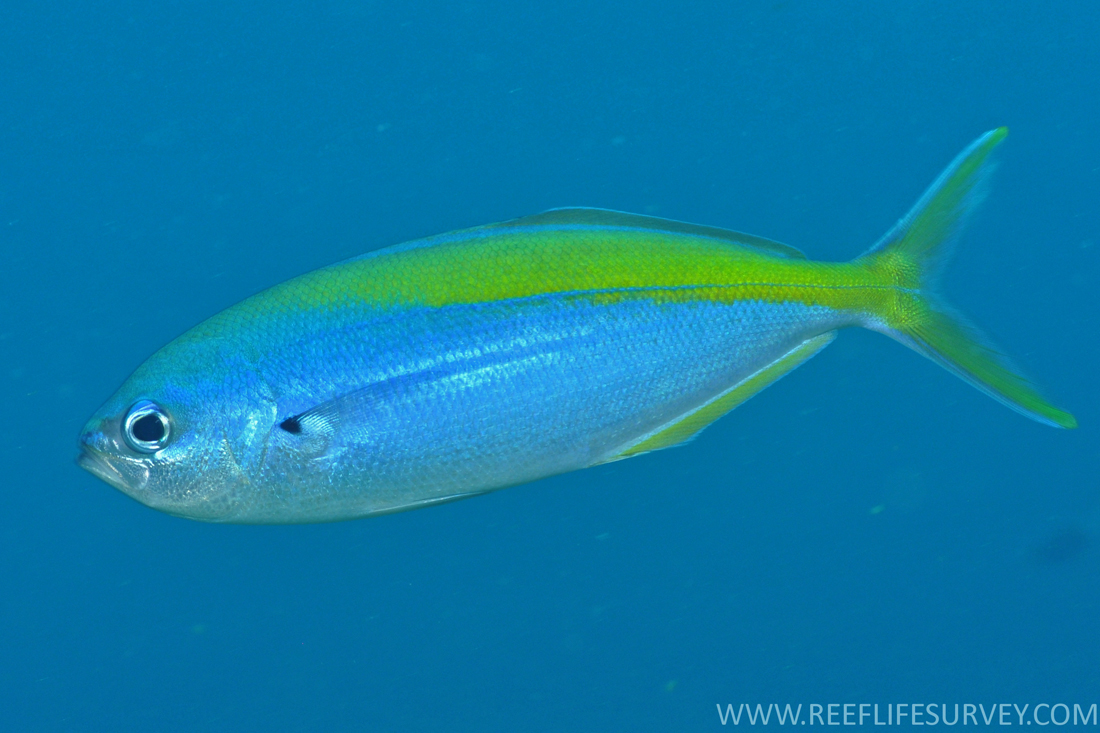Blue Knifefish, Labracoglossa nitida McCulloch & Waite 1916
Other Names: Grey Knifefish

A Blue Knifefish, Labracoglossa nitida, at Lord Howe Island on the Tasman Sea. Source: Graham Edgar / Reef Life Survey. License: CC BY Attribution
Summary:
A slender bright blue sweep becoming paler below with a broad yellow stripe along the back, caudal peduncle and tail, yellow caudal and anal fins, a fine blue streak extending into the yellow stripe along the lateral line, and a black spot/blotch on the pectoral-fin base. Blue Knifefish have low dorsal and anal fins and a deeply forked tail.
Cite this page as:
Bray, D.J. 2022, Labracoglossa nitida in Fishes of Australia, accessed 24 Apr 2024, https://fishesofaustralia.net.au/Home/species/2449
Blue Knifefish, Labracoglossa nitida McCulloch & Waite 1916
More Info
|
Distribution |
Tweed Heads to Sydney, New South Wales, and the Lord Howe Province and Norfolk Island in the Tasman Sea. Elsewhere the species occurs in northern New Zealand. Forms pelagic schools, usually in surface waters off headlands, and around pinnacles and offshore islands. |
|
Features |
Dorsal fin IX-X, 26; Anal fin III, 22-26; Pectoral fin 19-22; Pelvic fin I, 5; lateral-line (pored scales) 70-74; Gill rakers 32-35 (8-9 + 1 +23-25); Vertebrae 25 (10 + 15). Body depth 23-30% SL, upper and lower profiles similar; head short, length 25-28% SL; eye with a narrow posterior skin flap in fish over 12 cm SL; preopercular margin finely serrate; predorsal scales extend forward to at least nostrils. |
|
Feeding |
Feeds on zooplankton. |
|
Etymology |
The specific name is from the Latin nitida (= bright, shining, glossy), possibly on reference to the bright blue colour of this species. |
|
Species Citation |
Labracoglossa nitida McCulloch & Waite 1916, Trans. Roy. Soc. S. Aust. 40: 439, pl. 41(2). Type locality: Lord Howe Island. |
|
Author |
Bray, D.J. 2022 |
|
Resources |
Blue Knifefish, Labracoglossa nitida McCulloch & Waite 1916
References
Allen, G.R., Hoese, D.F., Paxton, J.R., Randall, J.E., Russell, B.C., Starck, W.A., Talbot, F.H. & Whitley, G.P. 1976. Annotated checklist of the fishes of Lord Howe Island. Records of the Australian Museum 30(15): 365-454 figs 1-2
Ayling, T. & Cox, G.J. 1982. Collins Guide to the Seafishes of New Zealand. Auckland : Collins 343 pp. 48 pls 475 figs.
Francis, M. 1993. Checklist of the coastal fishes of Lord Howe, Norfolk, and Kermadec Islands, southwest Pacific Ocean. Pacific Science 47(2): 136-170 figs 1-2
Francis, M. 2019. Checklist of the coastal fishes of Lord Howe, Norfolk and Kermadec Islands, southwest Pacific Ocean. https://doi.org/10.6084/m9.figshare.c.4428305
Francis, M.P., Grace, R.V. & Paulin, C.D. 1987. Coastal fishes of the Kermadec Islands. New Zealand Journal of Marine and Freshwater Research 21(1): 1-13.
Francis, M.P., Worthington, C.J., Saul, P. & Clements, K.D. 1999. New and rare tropical and subtropical fishes from northern New Zealand. New Zealand Journal of Marine and Freshwater Research 33: 571-586.
McCulloch, A.R. & Waite, E.R. 1916. Additions to the fish fauna of Lord Howe Island. No. 5. Transactions of the Royal Society of South Australia 40: 437-451 pls 40-43 See ref at BHL
Trnski, T. & Knudsen, S.W. 2015. Family Scorpididae. pp. 1324-1329, in Roberts, C.D., Stewart, A.L. & Struthers, C.D. (eds) The Fishes of New Zealand. Wellington : Te Papa Press Vol. 4 pp. 1153-1748.







